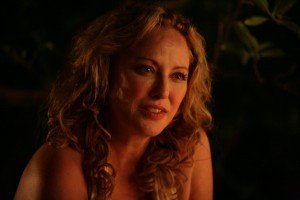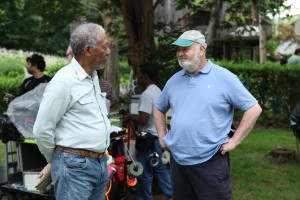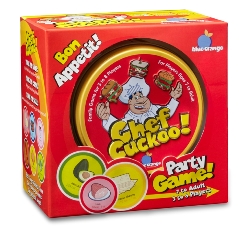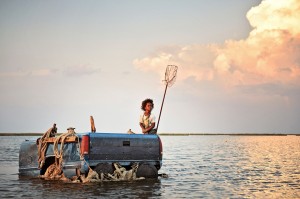Interview: Virginia Madsen of “The Magic of Belle Isle”
Posted on June 28, 2012 at 8:00 am
Virginia Madsen stars in the heartwarming story “The Magic of Belle Isle” as the recently-divorced mother of three girls who befriends the writer who moves in next door (Morgan Freeman). I spoke to her about making the movie, which is available now On Demand and will be in theaters July 6.
What was it like for you working with three young actresses who played your daughters? How do you develop a level of trust with them?
Well, I raised a child. I had a boy child who’s now 17 and I’ve worked with kids before. I know that this was a big job. We had a lot to do, they had a lot of dialogue and I really, really wanted them to trust me. One of the greatest things is that they all had nice parents. We struck gold with that. They were nice kids, they weren’t Hollywood-ized and the mothers really allowed me to mother their children which was incredibly trusting and generous. Slowly, I gained their trust and they could see how I wanted to be with their daughters, and that I was going to take good care of them. Before the movie started, I asked the art director and Rob if I could have a space on the set, a room that I could set up arts and crafts. Because that’s what I did with my son, and decided to bring music, and all the supplies. I said, “Just give me this room, but no one is allowed to go in it but us, that is the O’Neil house, and I don’t want a sound cart in there, I don’t want lights being stored, no makeup touches go on in this room, this is the O’Neil house and this is our sacred space.” And they loved it. And then the art department said, “Actually, there’s a sun room, we’ll make it a part of the movie.” And so when there was a break, this allowed me to keep us al together as a family and allowed them to remain focused and quiet when it wasn’t alright for them to play in the yard especially if it was raining. The next great thing was, they bonded as sisters. Madeline Carroll is really something special, and she helped shepherd the girls, she really loved those girls. She would sit and make necklaces with them. She was never bored or impatient like a lot of teenagers naturally would be.
She was the polar opposite of that character, the antithesis of that. She was—I maybe saw her texting twice during the whole thing. She just stayed with us. All the girls are all so different, but then they all remained really bonded and then they brought their friends in, some of the little kids from the neighborhood came to the O’Neil house…and I’d play classical music. Spanish guitar was the thing they liked the best, so I wasn’t playing any pop music. Everything was kind of our “Zen-space” and Maddy’s brother—they all had brothers, they were there with us. This allowed them to have a real relationship with me, and so that then when we went in on the set, I was taking the little one by the hand, or I was carrying her in, and then we would sit down and simply begin the scene and it worked very well. I loved it because it’s been such a long time since I’ve been able to do arts and crafts and I never had a girl! I never had a girl, so I was so happy that I had three! And they also went home at night! Although they came over to my house quite a bit.
They did?
It’s on my twitter page somewhere. If you go into my videos, it’s a while ago…but they came over to the house and I cooked for all of them, and it was their friends, the siblings, the moms, everybody came over and I cooked this huge dinner. If you look at the video, it’s this moment that I had been building up about desert. I said, “This desert, you’re going to lose your mind. You’re going to lose your mind.” I kept saying it all day long. And now…and they’re all at the kitchen counter, and I’m standing on the other side of it and I was like…”And now…you’re going to lose your mind!” So I take out a giant, huge bag of cool-pops, you know those frozen sticks? And I held it up like the Lion King, and they screamed…”Frozen pops, oh my God!” It was a massive, big, big pot of gold.
Do you really play the piano?
I played the piano until I was about 18 and then I left it when I came out to LA to be in movies. I had to play in another movie, a western that I did with Tom Selleck called “Crossfire Trail” and I had to play Für Elise, which is something that every girl at the time played. Completely had to relearn it, it was a nightmare, but this was fun. They gave me a piano in my house—because I wanted you to see my hands playing it. So when Morgan was listening to me, you’d already had the visual in your mind that it was really me. That was very important to me.
Was this the first time you had ever met Morgan Freeman?
No, he invited me to the AFI Lifetime Achievement tribute. Can you imagine, first of all, I meet him on the red carpet. He’s tall, he’s handsome, he was in a white tuxedo, a white jacket with black tie, and he just looked so cool, man. And I just went up to him and it was just, he had that big smile and the Morgan Freeman voice and I was like, “This is going to be just fine.” We just had instant chemistry. And then, not intimidating at all, to sit through two hours of magnificence and genius of Morgan Freeman and everyone telling what a genius he is…and I’m like, “I’m the luckiest girl in the whole wide world!” I was the luckiest girl in the room that night, and it did turn out to be just a breeze. It was easy to work with him.
There’s obvious chemistry between the two of you that’s very understated and nice. That touch of the hands at the end, I have to say really got to me.
And I was trying to think, when was the last time that a touch of the hand meant so much in a movie? Thank you for noticing that.





